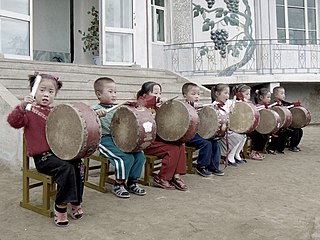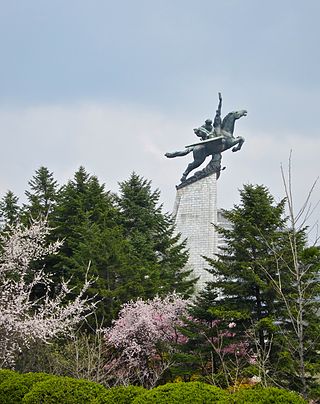
The contemporary culture of North Korea is based on traditional Korean culture, but has developed since the division of Korea in 1945. The Juche ideology conceived by Kim Il Sung (1948–1994) asserts Korea's cultural distinctiveness and creativity, as well as the productive powers of the working masses.

The music of North Korea includes a wide array of folk, pop, light instrumental, political, and classical performers. Beyond patriotic and political music, popular groups like Pochonbo Electronic Ensemble and Moranbong Band perform songs about everyday life in the DPRK and modern light pop reinterpretations of classic Korean folk music. Music education is widely taught in schools, with President Kim Il Sung first implementing a program of study of musical instruments in 1949 at an orphanage in Mangyongdae. Musical diplomacy also continues to be relevant to the Democratic People's Republic of Korea, with musical and cultural delegations completing concerts in China and France in recent years, and musicians from Western countries and South Korea collaborating on projects in the DPRK.

{{Infobox public transit | image = Logo of the Pyongyang Metro.svg | notrack = | host = | character = rapid transit | vehicles = 224 (Type D : 216, Type 1 : 8) | train_length = 4 | headway = 3 minute (peak)
5 minute (off-peak) | system_length = 22.5 km (14.0 mi) | track_gauge = 1,435 mmstandard gauge | operator = Pyongyang Metro Administration Bureau{{|ko|평양지하철도}} | ogauge = | minimum_radius_of_curvature = | el = | average_speed = | top_speed = 70 km/h (43 mph) | map = | marks = | began_operation = September 1973 | imagesize = 100px | locale = Pyongyang, North Korea | image2 = PYONGYANG METRO DPR KOREA OCT 2012 (8148604784).jpg | imagesize2 = 300px | caption2 = Type D | alt = A blue circle with red lettering inside it; underneath the circle is a red V | native_name = 평양 지하철도
P'yŏngyang Chihach'ŏlto | owner = | transit_type = Rapid transit | website = | lines = 2 | line_number = Chollima Line
Hyoksin Line | stations = 16 (Chollima Line : 8, Hyoksin Line : 8) | ridership = 400,000 (Weekdays)
700,000 (Holidays)
(July 2019) | annual_ridership = | chief_executive = | headquarters = Pyongyang Metro,
City Metro Unit,
Railway Section,
Transport and Communication Commission,
Pyongyang,
Democratic People's Republic of Korea | map_name = Route Map of Pyongyang Metro
Mansudae Overseas Projects is a construction company based in Jongphyong-dong, Phyongchon District, Pyongyang, North Korea. It is the international commercial division of the Mansudae Art Studio. As of August 2011, it had earned an estimated US$160 million overseas building monuments and memorials. As of 2015, Mansudae projects have been built in 17 countries: Angola, Algeria, Benin, Botswana, Cambodia, Chad, Democratic Republic of Congo, Egypt, Equatorial Guinea, Ethiopia, Germany, Malaysia, Mali, Mozambique, Namibia, Senegal, Togo and Zimbabwe. The company uses North Korean artists, engineers, and construction workers rather than those of the local artists and workers. Sculptures, monuments, and buildings are in the style of North Korean socialist realism.
The Mansudae Art Troupe is a North Korean troupe of musicians that create light-classical operas and music, as well as dance pieces.

Kim Il Sung Square is a large city square in the Central District of Pyongyang, North Korea, and is named after the country's founding leader, Kim Il Sung. The square was constructed in 1954 according to a master plan for reconstructing the capital after the destruction of the Korean War. It was opened in August 1954. The square is located on the foot of the Namsan Hill, west bank of the Taedong River, directly opposite the Juche Tower on the other side of the river. It is the 37th largest square in the world, having an area of about 75,000 square metres which can accommodate a rally of more than 100,000 people. The square has a great cultural significance, as it is a common gathering place for concerts, rallies, dances and military parades and is often featured in media concerning North Korea.

The Chollima Movement was a state-sponsored Stakhanovite movement in North Korea intended to promote rapid economic development. Launched in 1956 or 1958, the movement emphasized "ideological incentives to work harder" and the personal guidance of Kim Il Sung rather than rational modes of economic management.

Propaganda is widely used and produced by the government of North Korea (DPRK). Most propaganda is based on the Juche ideology and on the promotion of the Workers' Party of Korea.
Kim Song-gun is a North Korean painter. He works at the Mansudae Art Studio in Pyongyang.

The North Korean cult of personality surrounding the Kim family, has existed in North Korea for decades and can be found in many examples of North Korean culture. Although not acknowledged by the North Korean government, many defectors and Western visitors state there are often stiff penalties for those who criticize or do not show "proper" respect for the former leaders of the country, Kim Il Sung and Kim Jong Il, officially referred to as "eternal leaders of Korea". The personality cult began soon after Kim Il Sung took power in 1948, and was greatly expanded after his death in 1994.

The Korean Revolution Museum (Korean: 조선혁명박물관), located in Pyongyang, North Korea, was founded on August 1, 1948, and holds a large exhibition of items related to Kim Il Sung and the Korean revolutionary movement. It is situated behind the Mansu Hill Grand Monument and is adjacent to the Mansudae Assembly Hall, seat of the Supreme People's Assembly, the North Korean legislature.

The Mansu Hill Grand Monument is a complex of monuments in Pyongyang, North Korea. There are 229 figures in all, commemorating the history of the revolutionary struggle of the Korean people, and especially their leaders. The central part of the monument consists of two 22-meter-tall (72 ft) bronze statues of Kim Il Sung and Kim Jong Il.

On the Art of the Cinema is a 1973 treatise by the North Korean leader Kim Jong Il. It is considered the most authoritative work on North Korean filmmaking.
The People's Prize is a North Korean arts and sciences award. It is awarded by the People's Prize Awarding Commission, which is working directly under the Cabinet of North Korea. The prize can be granted to works of art or people. People's Prize has been an important award in the field of North Korean cinema.

The Monument to Party Founding is a monument in Pyongyang, the capital of North Korea.

The Chollima Statue (Korean: 천리마동상) is a monument on Mansu Hill in Pyongyang, the capital of North Korea. The monument symbolizes the "Chollima speed" of the Chollima Movement. The legendary winged horse Chollima depicted by the monument is said to travel 1,000 ri (400 km) a day.
The Kim Il Sung Prize (김일성상) is an award given by the Government of North Korea to persons in various fields who demonstrate exemplary service to the values of Juche idea. Past winners include the Korean composer Kim Won-gyun, judoka Kye Sun-hui, and the Arirang Festival.

Visual depictions of Kim Il Sung have been commonplace in North Korea since the 1940s following the example of Joseph Stalin in the Soviet Union and Mao Zedong in China. The display of Kim Il Sung portraits was made mandatory at homes in the 1970s. In the past, they were mandatory in certain public places as well, such as factories, airports, railway stations, and rail and subway carriages. At present, they no longer appear in means of transport, not even in some new buildings. Portraits of Kim Jong Il have been hung next to Kim Il Sung since the late 1970s. A portrait of Kim Jong Un was displayed for the first time in public in 2018.

The Samjiyon Band is a North Korean classical music ensemble.



![Chollima statue at the foot of Mansu Hill [ko] Chollima statue 05.JPG](http://upload.wikimedia.org/wikipedia/commons/thumb/a/a2/Chollima_statue_05.JPG/220px-Chollima_statue_05.JPG)














